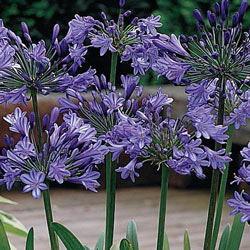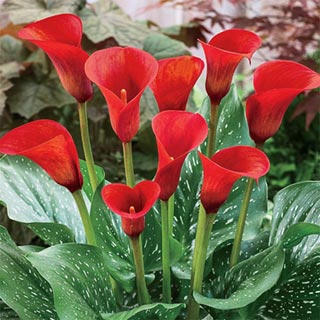When sleet is still rattling against the glass of the greenhouse, it’s hard to get your head into spring. But if you think ahead in March, you can take advantage of a glasshouse to get a head start on the summer garden by potting up tender bulbs.
These are plants such as agapanthus, with its spidery blue flowers; sculptural calla lilies; vivid red and orange crocosmia; elephant ears, with their huge, commanding leaves; and striking calla lilies. They  come from warm places in Asia, Africa and South America, so they can’t survive a cold winter in the ground. But they’ll make a real show once it gets warm enough.
come from warm places in Asia, Africa and South America, so they can’t survive a cold winter in the ground. But they’ll make a real show once it gets warm enough.
Theoretically, you can plant them right into well-drained soil in the garden. When I was a child visiting relatives in Texas, there were beds of bright red calla lilies everywhere. But if you try that in a place like Chicago, where the soil stays cool right into May, it will be practically autumn before the plants are fully in bloom. In order to enjoy these tropical and semi-tropical plants in a short growing season, you need to give them a head start indoors in pots.
You can do a plant or two if on a sunny windowsill or under lights indoors. But a greenhouse will work much better. You can plant the tubers in small grower pots for later transplanting, or, if you have the space, plant them right into the decorative pot they will spend the summer in. When the garden warms up, move the whole pot out to the patio or wherever you need a punch of color and drama.
Plant the tubers about the middle of March, so they have about a six-week head start before the last average frost date (which is about May 15 here in my part of Zone 5). It’s critical to use a good-quality potting mix that drains well. Keep the soil moist, but not sopping wet. Turn the pots from time to time so the plants grow evenly.
about May 15 here in my part of Zone 5). It’s critical to use a good-quality potting mix that drains well. Keep the soil moist, but not sopping wet. Turn the pots from time to time so the plants grow evenly.
They’ll do best with a moderate amount of fertilizer, either a slow-release form in the potting mix or a liquid applied by watering. (I always mix up soluble fertilizer at half the strength suggested on the package, just to make sure I don’t burn plants or push them too hard.)
It may seem paradoxical, but don’t keep the plants too warm, no more than the low 60s. If the air is too hot, they’ll either dry out or they’ll rush ahead and bloom before you even get them outdoors. You want good hopeful young plants by mid-May, but you want them to finish growing and bloom outdoors.
In fact, it’s often a good idea to do staggered plantings, a week or so apart, to allow for the vagaries of spring weather. You’ll have plants at different stages of growth just in case. Some may just bloom a little later when you move them outside, but they’ll all get a nice head start.


